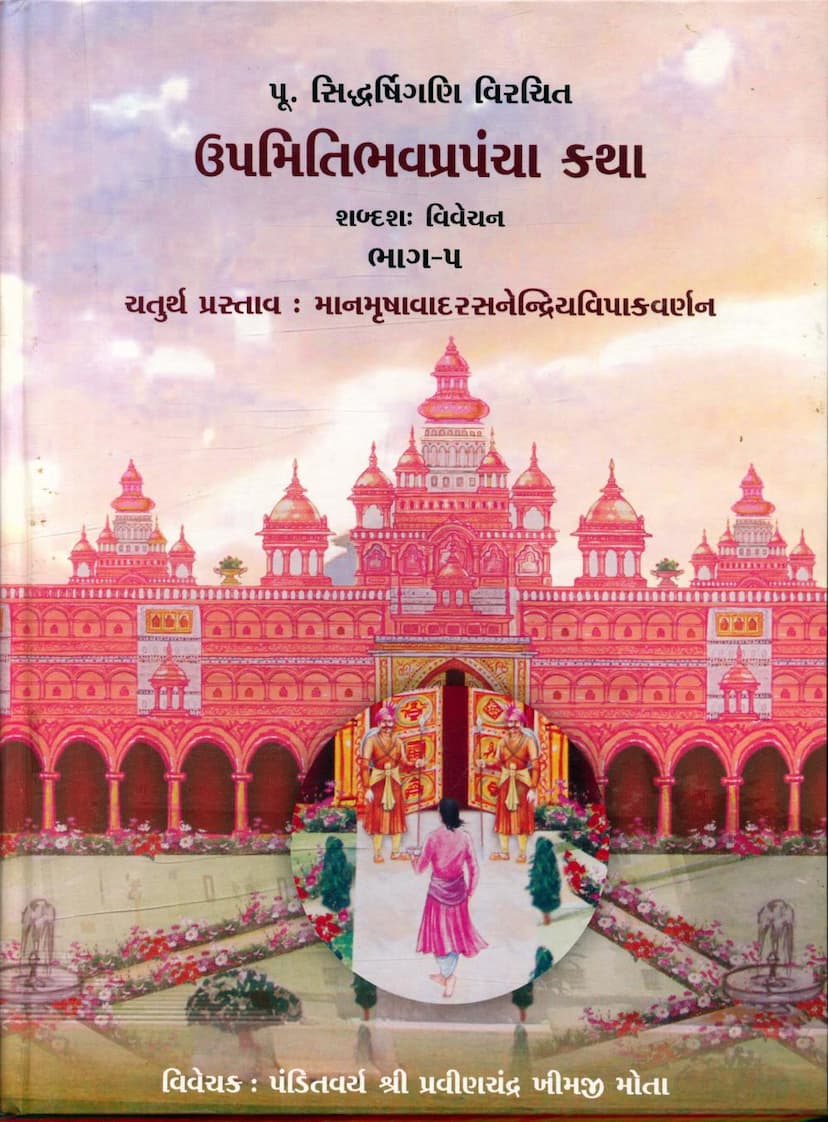Upmiti Bhav Prapancha Katha Part 05
Added to library: September 2, 2025

Summary
This Jain text, "Upmiti Bhav Prapancha Katha Part 05" by Pravin K Mota and published by Gitarth Ganga, is the fifth part of a commentary on the original work by Shri Siddharshigani. This specific volume focuses on the fourth "Prastav" (chapter or section) which details the consequences and descriptions related to pride, false speech, and the senses.
Key Aspects and Summary:
- Commentary and Spiritual Guidance: The book is a word-for-word commentary on the ancient Jain text "Upmiti Bhav Prapancha Katha." It aims to reveal the deeper, hidden meanings and truths within the scriptures. The publishers and commentators emphasize the importance of not just acquiring Jainism but understanding its profound secrets through knowledge and practice.
- Structure and Content: The commentary is presented in a scholarly manner, likely drawing from extensive scriptural knowledge. The table of contents, spanning pages 6-8, reveals a vast array of topics covered in this volume, including:
- Descriptions of seasons (winter, spring, summer, monsoon).
- The results of actions (karma) and the reign of kings like 'Moha Raja' (King of Delusion).
- The impact of vices like intoxication, gambling, hunting, meat-eating, and idle talk.
- The nature of emotions like joy and sorrow, and the cycles of life and death (four gatis).
- The characteristics of old age, illness, death, cruelty, ugliness, poverty, and bad conduct.
- The distinction between definitive (nishchay) and conventional (vyavahar) truths.
- The path to liberation and the absence of worldly desires.
- Critiques of non-Jain philosophies (Mithyadarshan) like those of Nyaya, Vaisheshika, Sankhya, Buddhism, and Lokayat.
- The Jain path to liberation, including the role of monks, contentment, and the nature of the pure city (Nivrutti Nagar).
- The concept of the mind's control, the seat of contentment, and the description of virtuous kings and cities.
- Detailed descriptions of character types and their actions, often allegorical, representing spiritual concepts.
- Spiritual Analogy: The introductory remarks highlight the plight of a person fumbling in darkness without a torch, comparing it to a soul lost in the cycle of birth and death without the light of Jainism. It further emphasizes that merely acquiring Jainism is insufficient; one needs deep knowledge of its secrets, unwavering respect for the teachings, and a firm resolve for spiritual practice.
- Scholarly Approach: The text is presented as a "Vidvadvogya" (worthy of scholars) and "Ashrutpurva Karya" (unprecedented work), requiring significant effort, resources, and time. The commentary by Pandit Shri Pravinchandra Khimji Mota is highly valued, along with the spiritual guidance from Acharya Shrimad Vijay Ramchandrasurishwarji Maharaj and Muni Shri Mohjitvijayji Maharaj.
- Compilation and Publication: The publication is a collaborative effort, with contributions from various scholars and trusts, aiming to make these profound spiritual insights accessible to the Jain community. The focus is on elucidating the "secrets" of the Jain doctrine through clear and accessible language, incorporating both traditional and modern perspectives.
- Detailed Content (Examples from page 10 onwards): The provided pages offer a glimpse into the detailed commentary. For instance, the description of Shishir Rutu (winter) uses poetic verses to illustrate the harshness of the season and the suffering it can cause, especially to those separated from loved ones or lacking basic necessities. It then moves to the discussion of 'Karma Parinam Moha Raja' and 'Moha Raja,' exploring their influence and the philosophical concepts behind them. The text delves into the allegorical representation of different states and forces within the spiritual journey.
In essence, this volume is a profound and comprehensive spiritual and philosophical discourse, aimed at guiding the reader towards a deeper understanding and practice of Jain principles by explaining the intricate meanings within the "Upmiti Bhav Prapancha Katha." It serves as an educational resource for those seeking spiritual enlightenment through Jain teachings.